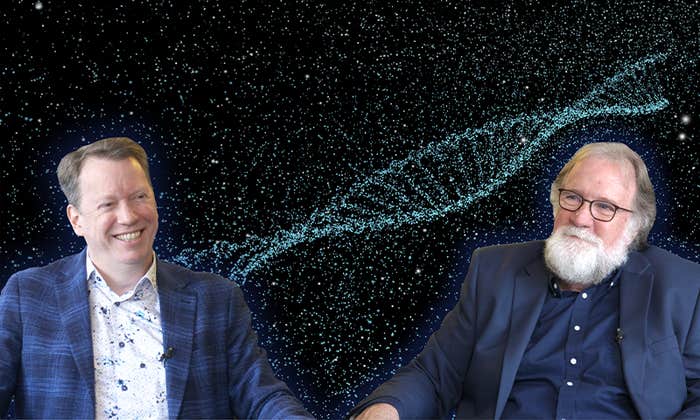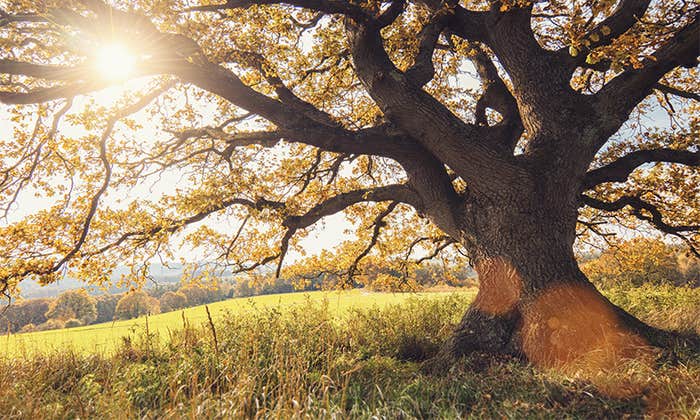This past fall I sat down with evolutionary biologists Peter and Rosemary Grant to talk about their new memoirs. We met at their home in Princeton, New Jersey. The three of us hadn’t had a long conversation for quite a while—not since they published Forty Years of Evolution, and that was 10 years back.
I first met the Grants in January 1990. I had heard a little about their extraordinary work, and I wanted to write a book about it. Every year, they spent months camped out in the Galapagos Archipelago, Darwin’s islands. There, on an impossibly bleak speck of rock called Daphne Major, they studied Darwin’s finches, the birds that helped lead him to his theory of evolution by natural selection.
To everyone’s surprise, including their own, the Grants had discovered that they could watch Darwin’s process in action. In the first pages of the On the Origin of Species, Darwin argues that evolution by natural selection goes on all the time, “daily and hourly.” However, he writes, the action is so geologically slow that you would need “the lapse of ages” to see it happen. That turns out not to be true. The Grants have witnessed an amazing amount of action—including the origin of a new species.
When we met, Peter and Rosemary were already famous within their field, but they were virtually unknown outside it. For several years, I lurked around the Princeton biology department where they taught, visited them on Daphne Major, interviewed their students, and pored over their research papers. I think the Grants both felt a certain amount of relief when my book, The Beak of the Finch, was finally published, in 1994. But I knew we were going to be OK when they invited my wife and me to the backyard wedding of their older daughter. (Their two girls had grown up, in part, on the slopes of Daphne Major.)
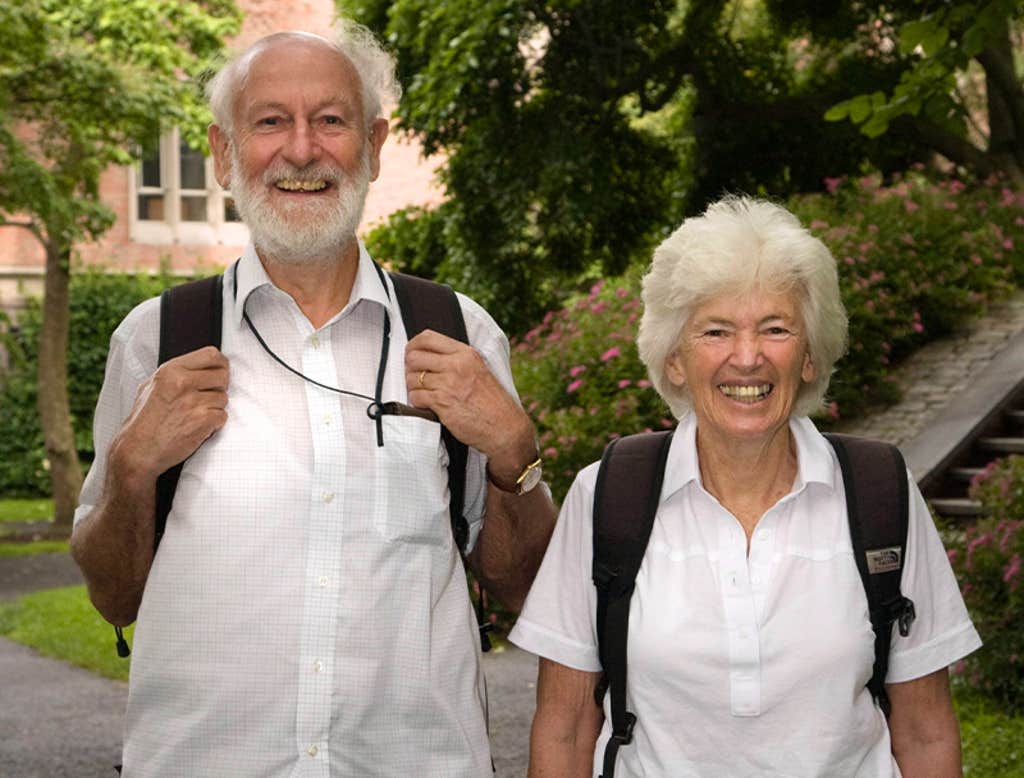
So now it was a sentimental journey to visit them once again. It was a bright, warmish morning in October. Rosemary had just turned 88, and Peter was about to turn 88, too. To me they seemed pretty much unchanged, still as charming and almost as vigorous as ever, although Rosemary had to interject now and then to help Peter with his hearing. (“Being deaf, or semi-deaf, I miss key words,” he said.) The house looked unchanged too, except for new solar panels. No sign anywhere of all the awards that have been showered on them in the past 30 years.
And now they’ve written their memoirs. For the Grants, that is a change. Back in the ’90s, when I was cadging interviews with them, they were so focused on the finches that they didn’t seem to realize that their own lives might be interesting, too. I’ll never forget the day I asked Peter to talk about his childhood. He told me, rather tersely, that as a little boy in the English countryside he’d once tried to catch a blue butterfly by hand. Then he ended the interview. He had to be getting back to work. He was very busy, he said. “But you seem to have all the time in the world.”
Having read his memoir, I understand his reticence at that moment.
The three of us had lunch, then moved to the living room, where Rosemary put out a pot of tea and a tray of McVitie’s biscuits, and we talked all afternoon.
Jonathan: I want to start with the memoirs. Having known you all these years, to hear all these stories is a delight.
Peter: That’s kind of you to say so. Because what one writes goes off into the public realm, and then there’s a silence. A few people will say, “Oh, I really like it.” But more say, “I’m so looking forward to reading your book.”
Rosemary: Or they’ll say, “It’s on my pile …”
[laughter]
Rosemary: I had a peculiar feeling when I was writing about my childhood. I found that I was spelling everything in the English way, which I’ve never done before. I was writing as a child. It was almost as though I had completely gone back, you know, 80 years or something. It was a weird sensation. And—
Peter: M’dear, if I could interrupt, and let you carry on in a second—I had a very different way of thinking about my childhood, which was that I was an observer of a little boy running around. So although I was him, I was also an observer of him. It was peculiar, I’ve never had that impression before. So, back to you …
Rosemary grew up in the coastal village of Arnside, in England’s Lake District. Her father was the village doctor. “Throughout my childhood,” she writes in her memoir, “horses were used to plow the fields and deliver milk and coal … In the 1930s, the village had three telephones, the numbers being 1 for the pub, 2 for the vicar, and 3 for the doctor, my father.” As a child, she loved roaming the countryside hunting for fossils and watching all the waterbirds (“turnstones, redshanks, curlews, sanderlings, shelducks, and Greylag geese”). When she was at home, she trailed around after the family gardener, Jeremiah Swindlehurst, asking questions. Why, for instance, weren’t all of the cabbages in the same row exactly alike? Why weren’t all the birches alike, or the oaks, or the robins, or the finches?
Rosemary: I kept asking Jeremiah—such a wonderful name—why was there so much variation? He said, “Oh, well, it’s all due to the environment.” He showed me how things grow differently in the sun and in the shade, that sort of thing. And then my father also answering it by saying, “Yes, everybody’s different, and I have to take this into account when I’m giving people medication.”
So I was fascinated with this problem of variation. I remember playing a game at home with my brothers. John had black hair and brown eyes. I had brown hair and greenish eyes, and my little brother, Andrew, had fair hair and blue eyes. And we would say to our parents, “Well, if you have another child, what’s it going to be like?”
When I was 12, my father said, if you’re so interested in biology, why don’t you read Darwin’s Origin of Species? We didn’t have it in the house. So I went all the way into Kendall on the bus to get it from the library, came back, and read chapter one, all this boring stuff about pigeons. I thought, “Oh, Lord, this is not what I’m interested in.”
My parents were very good. My mother said, “Okay, well, we’ll go and see a pigeon breeder.” And then pigeons became fascinating, because the breeder had his pouter pigeons and fantails and tumblers and all the things that Darwin had talked about. And what really blew my mind away was that pigeons had been used to take messages to the front lines in the war. And Julius Caesar had done this, too.
My parents were always very good when we asked questions—not just explaining things simply, but going into the answers in depth. That’s wonderful.
But then, at the same time, I was a girl. Back then, if you were a girl, the whole education process was geared to you getting married. You learned how to look after a house and look after a family, and that was it. That was it.
Peter was born in a suburb of South London. When he was 2 years old, his parents separated, and later divorced. “I was awarded by the court to my father, who was the ‘wronged party,’” he writes in his memoir. When he was 4, he was sent out to the countryside to escape the London Blitz. Between the ages of 4 to 8, he was boarded in a school in Surrey.
He fell in love with nature in a nearby park and down in a pit in front of the school, which they called The Dell. The pit had been formed by a bomb dropped by a German plane early in the war, and it was now as lush as a meadow. That was where Peter chased that blue butterfly—in The Dell. Many child evacuees from that time felt abandoned by their parents. “If I felt the same,” he writes, “the feeling and memory have been lost in the mists of time.” Birds, butterflies, and flowers became bright spots during years so bleak that he hardly talked about them until he reached the age of 60.
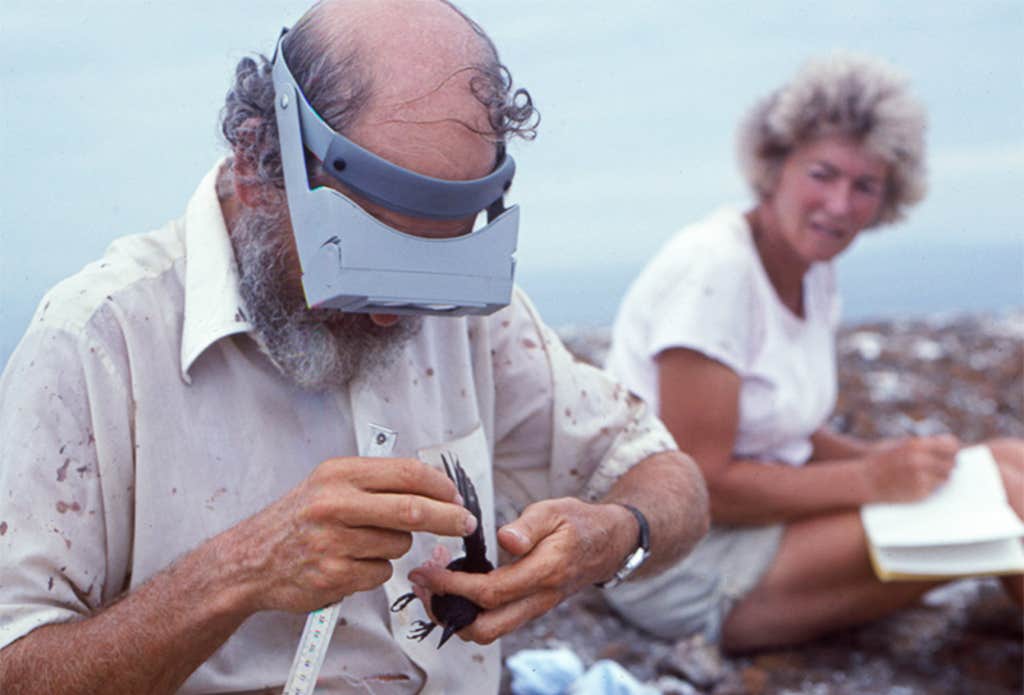
Peter: I’m really intrigued by the fact that I just absolutely worshipped nature, right from being knee high to a grasshopper—yeah, grasshoppers, amongst many other things. And why?
All my schoolmates when I was 4, 5, 6, 7, out in the country—they were inside when I was outside looking at swallows flying around and looking where the birds were nesting and wondering if I could climb the trees to get there, that sort of thing. I mean, a typical little child naturalist.
And where did I get it from, when it was not my parents? My father was actually a little bit scared in the countryside. My mother never had any feeling for the countryside, either, and neither of them had any influence in showing me plants or identifying a butterfly. So I didn’t get it that way. I didn’t get it from any of the teachers at this school, either. But I was naturally predisposed, even then, to look at flowers and admire their pretty petals, identify butterflies and try to catch them, even at a very early age. And so that remains an enigma to me.
Rosemary had to struggle fiercely to get a good college education. By force of will, she made it to the University of Edinburgh, where she studied with Douglas Falconer, a world authority on quantitative genetics, the study of variation in animals and plants.
Peter went to Cambridge, where Darwin had studied more than a century before.
The two of them met as graduate students in 1960. They were in their mid-20s, two young biologists at the University of British Columbia, in Vancouver. When they first bumped into each other, as Peter recalls the scene, he was carrying a pair of skis.
“Those skis are too small for you,” Rosemary said.
“No, they are not,” said Peter.
“Yes, they are, I can see just by looking at them.”
One year later they were engaged. The next year they were married in Rosemary’s village, Arnside. As they stood on the altar, Peter whispered in Rosemary’s ear, “I heard this morning that the DNA code has been cracked.” The newlyweds spent part of their honeymoon in New York City, measuring bird specimens in the American Museum of Natural History.
In 1973, when they began their now-celebrated study of Darwin’s finches, they didn’t know they’d found their life’s work. They thought they’d be working in the Galapagos for just a few years. The breakthroughs that the Grants and their students made there have been described many times in the Grants’ books and papers, and in my own book, and most recently in a second edition of Forty Years of Evolution, which adds yet another decade to one of the most remarkable long-term projects in the history of science.
I asked the Grants to do a very quick summary of the highlights of their research.
Peter: Number one is the discovery that evolution occurs and is study-able within our time. Number two is the discovery that hybridization and backcrossing, although rare, does occur—
Jonathan: I’m sorry, Peter, but “hybridization and backcrossing” will be Greek to non-specialists.
Peter: Put into different language: Species A breeds with Species B, which is hybridization.
Rosemary: On Daphne Major, we saw fortis mate with scandens. [That’s Geospiza fortis, the medium-beaked ground finch, and Geospiza scandens, which is a cactus finch.] They were hybridizing at a very low frequency, a really low frequency, only about 1 or 2 percent of the time. Under good conditions, when there was lots of food on the island, the hybrids actually survived, and then they bred with one or the other of the parental species. And that’s backcrossing.
Peter: By backcrossing, a hybrid’s genes can flow back into one of the parental populations.
Rosemary: Often the reason they hybridize is that they learn the song of the other species. They learn to sing while they are little birds in the nest, during a very short, sensitive period of time. If, during that sensitive period, the father dies and the young in the nest hear the song of a neighbor, and the neighbor is another species, then the young birds will learn that species’ song. Learning the wrong species’ song leads to hybridization.
Jonathan: Right. So we’re marching through your list. That’s number one and number two. What’s number three?
Peter: Number three is the Big Bird story, which is a story of speciation by hybridization. It’s a story that starts with the arrival of a mysterious bird on Daphne. We thought it looked like a fortis but didn’t sing exactly like a fortis, and it did not have exactly the same proportions either. Later, a genomic study revealed that this bird was not a fortis, it was a conirostris.
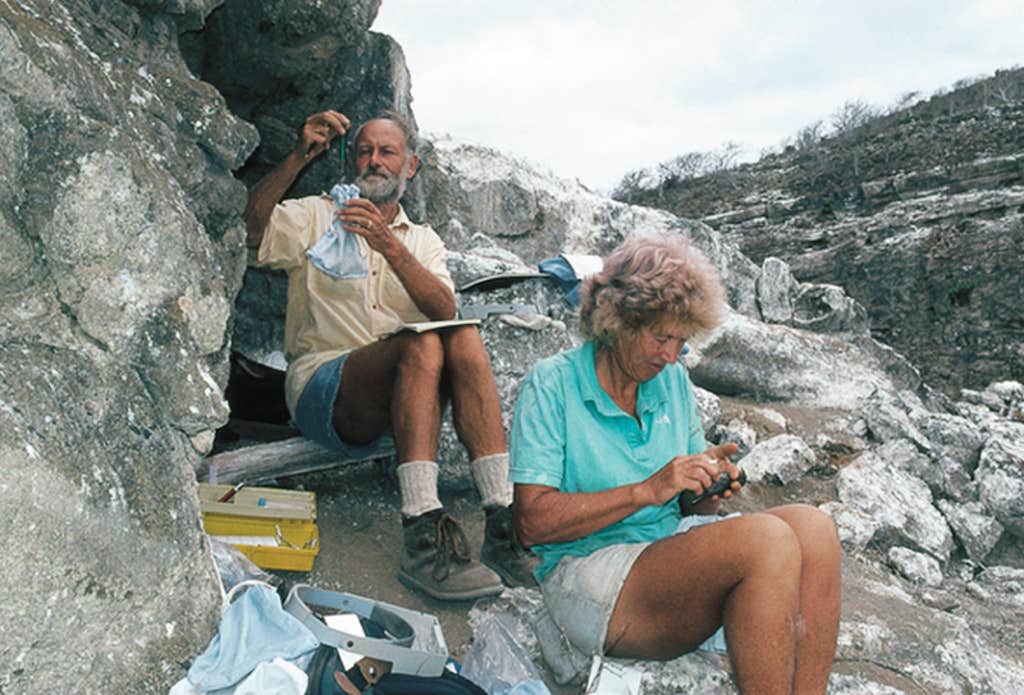
Rosemary: It was a pure conirostris from Española, an island far away in the southeast part of the archipelago.
Peter: This Big Bird bred with fortis on Daphne. So here was another case of hybridization. And after two generations, the offspring were breeding amongst themselves and not with fortis anymore. They were behaving essentially as a separate species.
Rosemary: We followed them for three more generations, all breeding amongst themselves. So they were completely separate from all the other species on the island, and they sang a different song. Big Bird had brought his song over with him. They all sang the original Big Bird song, and they were different in size and different in beak shape.
Jonathan: In your view, how important is hybridization in the origin of species?
Rosemary: It’s very important. Now that we have looked at the genetics of the whole group of Darwin’s finches, we think this has probably happened quite frequently in the past. We think now that these sorts of events have been winking in and out, and in and out, and sometimes leading off to a new species.
We think this is a very common phenomenon, not just in finches but in all organisms, including everything from viruses to all animals.
Jonathan: That’s fascinating.
Rosemary: And think of cancer. The similarity is strange; but if you think of cancer in the colon and cancer in the lung, let’s say, the cancer is dividing in two very different ecosystems. It’s like the birds multiplying on different islands with different ecologies. So you have cancer cells in the lung and the colon, and then they meet: They go through the blood system and fuse together, and multiply, and you get a different cancer.
The Grants retired from teaching at Princeton in 2008, and their last visit to Daphne was in 2019. For years now they’ve been fortunate to be able to continue the finch-work from home, collaborating with a stellar team of genomicists at Uppsala University in Sweden to learn whatever they can learn from the DNA of Darwin’s finches.
First, Swedish geneticist Leif Andersson and his team in Uppsala sequence the whole genome of a finch from the DNA samples that Peter and Rosemary supply. The sequencing machines determine the nucleotides of each and every chromosome throughout their length. Then Andersson and his colleagues can compare the chromosomes of two individual birds point by point to find places where they differ and where they are the same. They might compare and contrast two fortis, let’s say, or a fortis and a conirostris. “It’s like holding up two strings side by side and seeing where they match and where they don’t,” Peter says. “The don’ts are informative. They tell us where the species differ most.”
I asked Peter and Rosemary for a brief summary of the work they’ve done with Leif Andersson.
Peter: Our association with Leif started in 2012 with a small paper about color polymorphism in the beaks of the finches. That led us to ask, with his help and his expertise, much broader and deeper questions.
Genomics has revealed a great deal of finch history: that is, which species are related to which, how they are related, and how the pattern of relatedness unfolded through time. We found good reason for thinking there are more than the 14 species that we’d thought were there. We split a few, and finished up with the number 18.
[Here Peter paused, staring out the window.] Excuse me, I’m being sidetracked by a mockingbird over there. Oh, it’s gone into the holly bushes.
Rosemary: The breakthrough was getting blood. Fortunately, we had taken blood samples from every finch that we had measured since 1988. So one of the things we now know is that the whole radiation of the finches is really quite young; it’s between 1 and just over 1 million years old. Secondly, there is a burst of radiation about 250,000 years ago.
Peter: You get this sudden burst of radiation.
This was a time of great climatic disturbance in Earth history. It’s a time when there’s a big oscillation twice over: from full glacial conditions to full interglacial conditions and back again.
We’re familiar with the Last Glacial Maximum about 120,000 years ago. Well, that was a single peak, as it were, in conditions. But about 200,000 to 250,000 years ago, there was a double peak. And so, at this time of great environmental upheaval, we think that maybe conditions favored—in ways that we can only guess—the splitting of lineages into more species. The fact is that seven out of the 18 species of Darwin’s finches originated at that time, according to the genomic work.
These studies also told us that hybridization, which we have been studying in contemporary time, has been going on for a very long while, maybe close to a million years. One of the early branches of the finch family tree, one of the warbler finch groups, is genetically similar to other species that were formed later, in ways that can’t be explained just by common inheritance, but must be explained by exchanging genes.
We also confirmed that during a drought, when survival was at a premium, natural selection acted not only at the phenotypic level—that is, on the measurements of the beaks—but at the genotypic level as well.
Rosemary: So that was really nice. The genomics work matched absolutely exactly what we’d shown in the field. It’s wonderful to see the genetic underpinning of what we had seen in the field.
Jonathan: That’s amazing.
Peter: With the Big Birds, of course, we’d love to go back to the island and find out what has happened since we were there. A postdoc from Leif’s lab did go back, and took blood samples, and measured birds as well. But we haven’t got the sequences yet, so we can’t say anything.
We talked on as the sun began to set. The Grants had much more to say about genomics, plate tectonics, ocean currents, hybridization, the genes that shape birds’ beaks and human faces, and, of course, the origin of species. Among many other things, the genomics work has revealed that Darwin’s finches are not really finches at all. Officially they are now classified as tanagers. In the northeastern United States, their most famous relative is the Scarlet Tanager, which lives in the crowns of trees, singing a song that is sometimes described as sounding like “a robin with a bad cold.”
Before I left, I asked a question that I’d first asked the Grants back in the 1990s. Is there any sign that climate change is now disrupting the course of evolution in the Galapagos Islands? Peter told me that there are changes in the Pacific, but the signal has not yet been detected on land, mostly because the archipelago lies right at the equator.
Peter: Someday somebody will be able to put together a large amount of data and say, “Yes, we’re just beginning to see some effect.” But it’s very hard to predict what will happen—other than that the islands will be changed. Yes, maybe there will be a signal in the terrestrial environment as well, by the time we leave the planet. ![]()
Lead photo: Peter and Rosemary Grant on Daphne Major in 1991. In those days, the only way the Grants could write to the outside world was by handing a letter to a passing fisherman, or to one of their very rare visitors. In this case, the visitor was Jonathan Weiner. Photo courtesy of Jonathan Weiner.



























